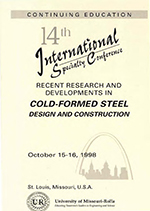Session Dates
15 Oct 1998
Abstract
Construction employing composite steel-concrete structures has been increasingly applied in building and bridge structures, and solutions involving cold-formed profiles have recently appeared which, in many cases, have resulted in reduced costs. Because constructions using composite steel-concrete structures, involving cold-formed profiles, are not covered by current Brazilian Codes, it is necessary to investigate the issue. This paper, therefore, presents the results of an experimental analysis (24 push-out tests) made for two types of connectors: U-profile and angle, with two plate thicknesses: 2.65 mm and 4.76 mm, evaluating their strength and their load-slip behavior. The tests were performed on test specimens adapted to those proposed by the British Standard BS 5400 - part 5 and by EUROCODE 3.
Department(s)
Civil, Architectural and Environmental Engineering
Research Center/Lab(s)
Wei-Wen Yu Center for Cold-Formed Steel Structures
Meeting Name
14th International Specialty Conference on Cold-Formed Steel Structures
Publisher
University of Missouri--Rolla
Document Version
Final Version
Rights
© 1998 University of Missouri--Rolla, All rights reserved.
Document Type
Article - Conference proceedings
File Type
text
Language
English
Recommended Citation
Malite, Maximiliano; Nimir, Walter A.; de Sales, Jose Jairo; and Goncalves, Roberto Martins, "Cold-formed Shear Connectors for Composite Constructions" (1998). CCFSS Proceedings of International Specialty Conference on Cold-Formed Steel Structures (1971 - 2018). 2.
https://scholarsmine.mst.edu/isccss/14iccfsss/14iccfsss-session7/2
Cold-formed Shear Connectors for Composite Constructions
Construction employing composite steel-concrete structures has been increasingly applied in building and bridge structures, and solutions involving cold-formed profiles have recently appeared which, in many cases, have resulted in reduced costs. Because constructions using composite steel-concrete structures, involving cold-formed profiles, are not covered by current Brazilian Codes, it is necessary to investigate the issue. This paper, therefore, presents the results of an experimental analysis (24 push-out tests) made for two types of connectors: U-profile and angle, with two plate thicknesses: 2.65 mm and 4.76 mm, evaluating their strength and their load-slip behavior. The tests were performed on test specimens adapted to those proposed by the British Standard BS 5400 - part 5 and by EUROCODE 3.



